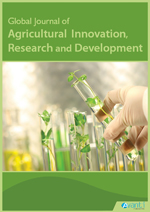Abstract
Agricultural machinery and farm equipment are potential sources of infectious material that can lead to the contamination and spread of diseases if proper action isn’t taken. Two stage decontamination methods, involving power washing followed by disinfectant applications, are needed to clean farm equipment, agricultural transport vehicles, and storage units. The field experiments confirm that pressure washing surfaces is an extremely important step in enhancing spore efficacy. Log10 reduction values were 5.45 and 2.90 for disinfectant applications with and without power washing, respectively. Both experiments show that the commercial chlorine dioxide disinfectant Electro-Biocide was an effective disinfectant alone and when mixed with adjuvants. Increasing the concentration of some tested adjuvants resulted in more spores being removed or killed, however this was not true for all adjuvants tested in these two experiments.References
Beck GK, Zimmerman JD, Schardt J, Stone RR, Lukens S, Richard J, Randall AA, Cooper D, Thompson JP. Invasive Species Defined in a Policy Context: Recommendations from the Federal Invasive Species Advisory Committee. Invasive Plant Sci Manag 2006; 1(4): 414-21. https://doi.org/10.1614/IPSM-08-089.1
Alaska Department of Fish and Game. Invasive Species: Methods of Introduction. http://www.adfg.alaska.gov/- index.cfm?adfg=invasive.pathways (Accessed May 1, 2018).
National Wildlife Federation. Invasive Species https://www.nwf.org/en/Educational-Resources/Wildlife- Guide/Threats-to-Wildlife/Invasive-Species (Accessed May 1, 2018).
Balbach R, Rew L, Fleming J. Evaluating the Potential for Vehicle Transport of Propagules of Invasive Species. U.S. Army Corps of Engineers 2008. www.erdc.usace.army.mil (Accessed May 1, 2018).
Alphin RL, Ciaverelli CD, Hougentougler DP, Johnson KJ, Rankin MK, Benson ER. Postoutbreak disinfection of mobile equipment. Avian Dis 2010; 54(1): 772-76. https://doi.org/10.1637/8763-033109-ResNote.1
Agriculture and Consumer Protection. Manual on the preparation of national animal disease emergency preparedness. http://www.fao.org/docrep/004/X2096E/X2096E06.htm (Accessed May 1, 2018).
Merriam-Webster. Quarantine. https://www.merriamwebster. com/dictionary/quarantine (Accessed May 1, 2018).
OSHA: United States Department of Labor. Hazardous Waste: Decontamination. https://www.osha.gov/SLTC/- hazardouswaste/training/decon.html (Accessed May 1, 2018).
Block SS. Disinfection, Sterilization, and Preservation, 5th ed. Lippincott, Williams, and Wilkins 2000.
University of Colorado-Boulder. Resources: Disinfectants and Sterilization. https://ehs.colorado.edu/resources/disinfectants-andsterilization- methods/#references (Accessed May 1, 2018).
Lenntech. Chemical Disinfectants: Disinfectants Sodium Hyopchlorite. http://www.lenntech.com/processes/disinfection/chemical/disi nfectants-sodium-hypochlorite.htm (Accessed May 1, 2018).
Kirk E. Bacillus subtilis.” Missouri S&T Microbiology 2009. (Accessed May 1, 2018).
Utkhede RS, Smith EM. Promotion of apple tree growth and fruit production by the EBW-4 strain Bacillus subtilis in apple replant disease soil. Can J Microbiol 1992; 38: 1270-73. https://doi.org/10.1139/m92-209
Asaka O, Shoda M. Biocontrol of Rhizoctonia solani damping off of Tomato with Bacillus subtilis. Appl Environ Microbiol 1996; 62: 4081-85.
Emmert EAB, Handelsman J. Biocontrol of plant disease: A Gram Positive Persepctive. FEMS Microbiol Lett 1999; 171: 1-9. https://doi.org/10.1111/j.1574-6968.1999.tb13405.x
Maillard JY. Innate resistance to Sporicides and potential failure to decontaminate. J Hosp Infec 2010; 77: 204-09. https://doi.org/10.1016/j.jhin.2010.06.028
Suslow T. University of California: Oxidation-Reduction Potential (ORP) for Water Disinfection Monitoring, Control, and Decontamination 2004; Publication 8149.
NSW Health. Oxidation-reduction Potential http://www.health.nsw.gov.au/environment/factsheets/Pages/ orp.aspx (Accessed May 1, 2018).
Burt, C. Tests of significance in factor analysis. British J Phys; Statistical Section 1952 V(3): 109. https://onlinelibrary.wiley.com/doi/pdf/10.1111/j.2044- 8317.1952.tb00117.x(Accessed on May 7, 2018).
Guan J, Chan M, Brooks BW, Rohonczy E, Miller LP. Vehicle and Equipment Decontamination During Outbreaks of Notifiable Animal Diseases in Cold Weather. J ABSA Int 2017; 22(3): 114-122. https://doi.org/10.1177/1535676017719846
Ramirez A. Animal Health: Four steps to effective cleaning and disinfecting. National Hog Farmer 2009. http://www.nationalhogfarmer.com/health-diseases/1015- effective-cleaning-disinfecting-steps (Accessed May 1, 2018)
All the published articles are licensed under the terms of the Creative Commons Attribution Non-Commercial License (CC BY-NC 4.0) which permits unrestricted, non-commercial use, distribution and reproduction in any medium, provided the work is properly cited.




